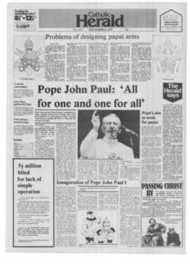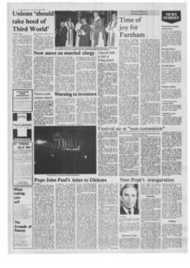Page 1, 8th September 1978
Page 1

Report an error
Noticed an error on this page?If you've noticed an error in this article please click here to report it.
Tags
Share
Related articles
Heim Draws Papal Arms
Briefly . . .
A Call To Heraldic Arms
Scandinavian Post
Archbishop Bruno Heim. The Swissborn Apostolic Delegate...
Problems of designing papal arms
By John Carey Pope John Paul has given his approval to the new papal coat of arms designed and executed by Archbishop Bruno Heim the Apostolic Delegate to Great Britain.
It is the fourth time that Archibishop Heim has drawn up a design for a Pope: he is one of the world's leading experts on heraldic design.
He said this week that on each occasion there had only been a short time in which to prepare them but that the unpredictable outcome of the election this year had presented particular problems. In the past he had had a pretty good idea of who the new Pope would be, he said: "But this time there were so many who could have been elected, so I was not sure what would need to be done."
When Pope Paul was elected, he had had a design ready the
day before the conclave had ended, he said.
Archbishop Heim has drawn up two designs (shown left and right): both are interchangeable in their usage. As with the choice of his name, Pope John Paul expressed his desire to incorporate features of the coats of arms held by his two immediate predecessors, Pope John XXIII and Pope Paul VI. Hence the design shows the lion of St Mark, which Pope John had had, and the six mountains of Rome asked for by Pope Paul.
In addition, of course, the coat of arms includes the essential elements of the papal Insignia, the tiara and the crossed keys with the shield. The stars, which are golden, represent the three great virtues of faith, hope and love and are on a background of azure blue.
Archbishop Heim said that the tiara had been included despite Pope John Paul's decision to do away with the formal coronation because it was a traditional mark of the papacy: he added "Even if he was not crowned, the tiara remains on his coat of arms. And I noticed on the television that he had it on his mitre during the ceremony."
Events moved swiftly after the announcement of Pope John Paul's election on the Saturday night. On Sunday, Archbishop Heim was told of what the new Pope wanted in his coat of arms. The following day, he sent the designs by the Diplomatic Bag carried by the Vatican courier and this was received and approved by the Pope on Tuesday.
Archbishop Heim said that the Pope had shown a great interest in the design and had asked several questions about it, such as whether the stars had five or six points. He added that the Pope had said later that he was very pleased.
In fact, the work was not as difficult as it might have been, Archbishop Heim said. He was helped by the fact that the Pope had chosen to include the lion of St Mark, which he had had while Patriarch of Venice, and the mountains of Rome. Both were features with which he was already familiar he said.
All that remained was to fill in the shield.
His task was also made easier by the close co-operation of the Sostirtgo, Archbishop Caprio, who acted as go-between. Nevertheless, the speed at which Archbishop Heim completed the design is a tribute to his skill as a craftsman.
Papal coats of arms always present very pressing problems. As soon as the election is over, the vast machinery of administration and organisation
starts moving in order to get the new coat of arms ready as soon as possible.
It will appear on coins, postage stamps, letter headings, and especially in the papal seal and it is always embroidered on the stole which the Pope wears when he receives diplomats and on the tapestry which is hung from the Vatican balcony. It becomes immediately the most widely known heraldic embelm in the world.
But for Archbishop Heim, there was anothere was another factor giving his work an added urgency: the publishers of his new book, Heraldry in the Catholic Church, due to be published on October 26, were breathing down his neck. All the colour plates and the hundreds of monochrome illustrations had already been printed, and a separate plate &the new coats of arms had to be processed before the books could be bound.
blog comments powered by Disqus











